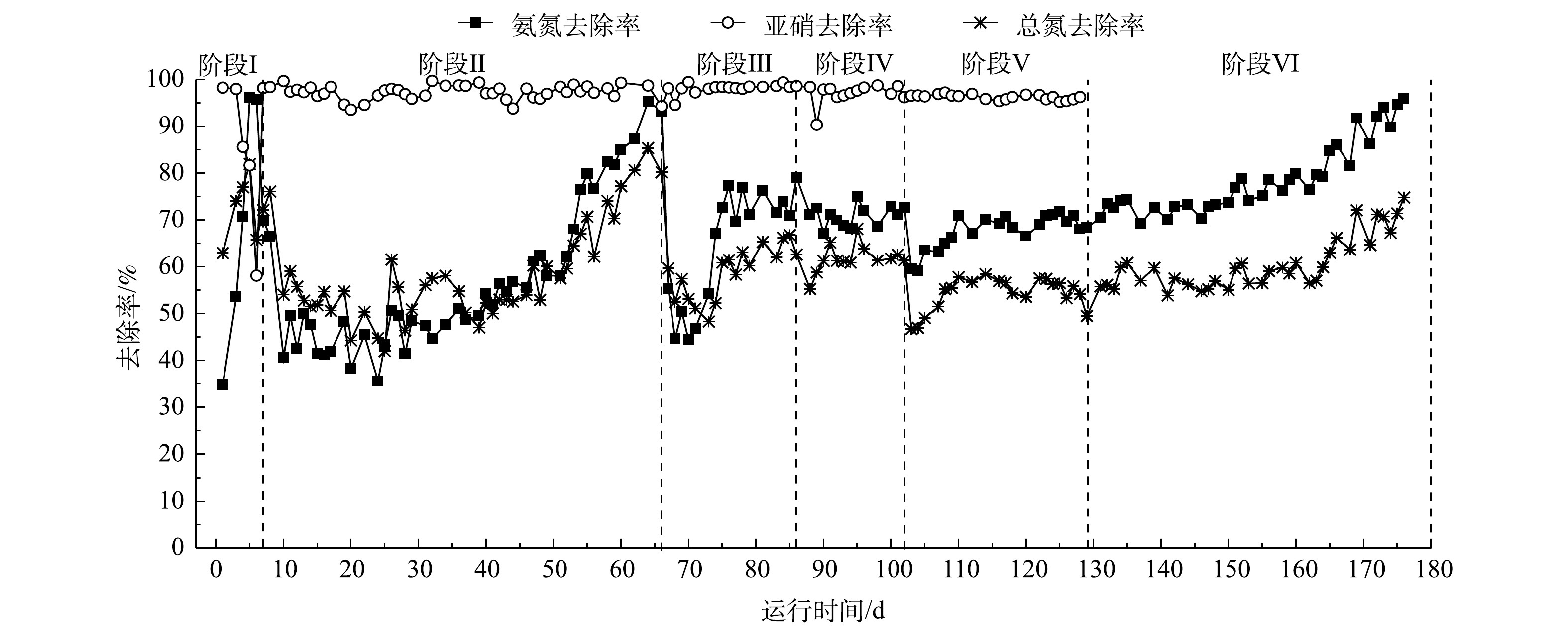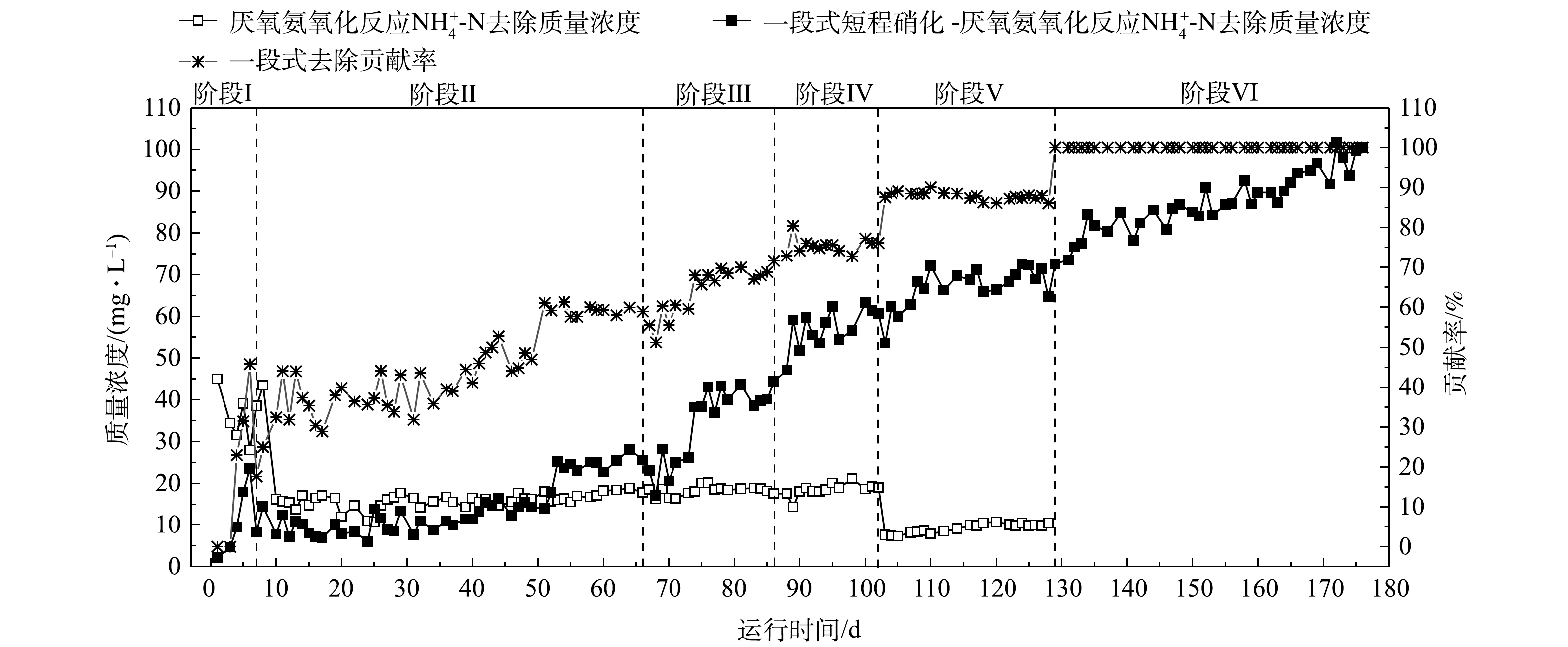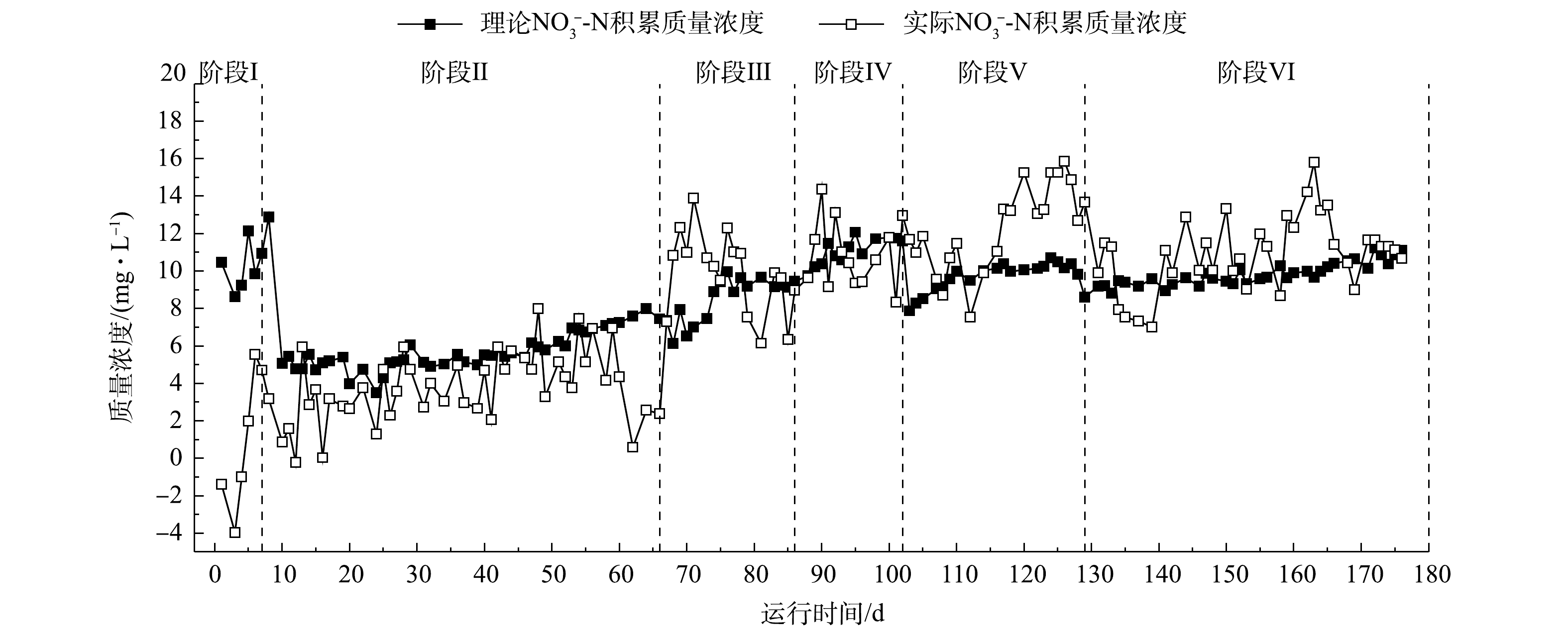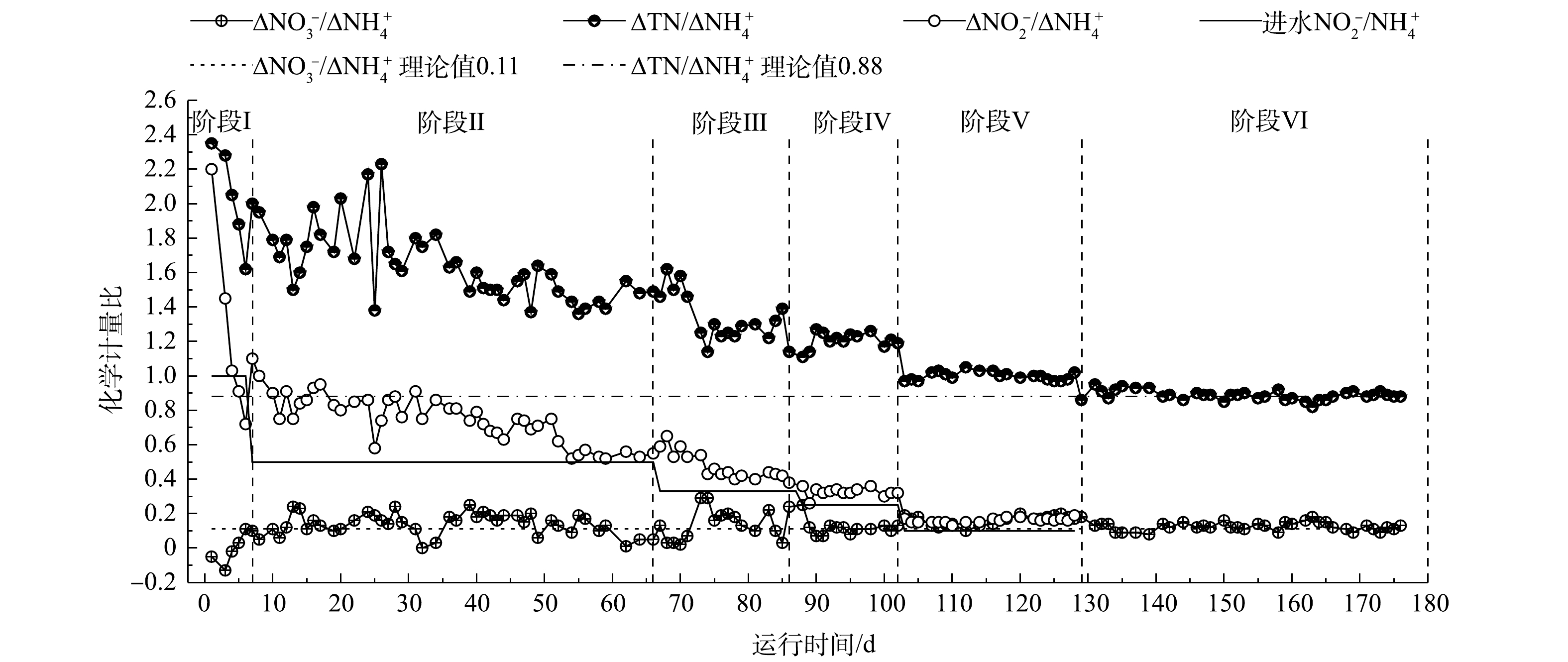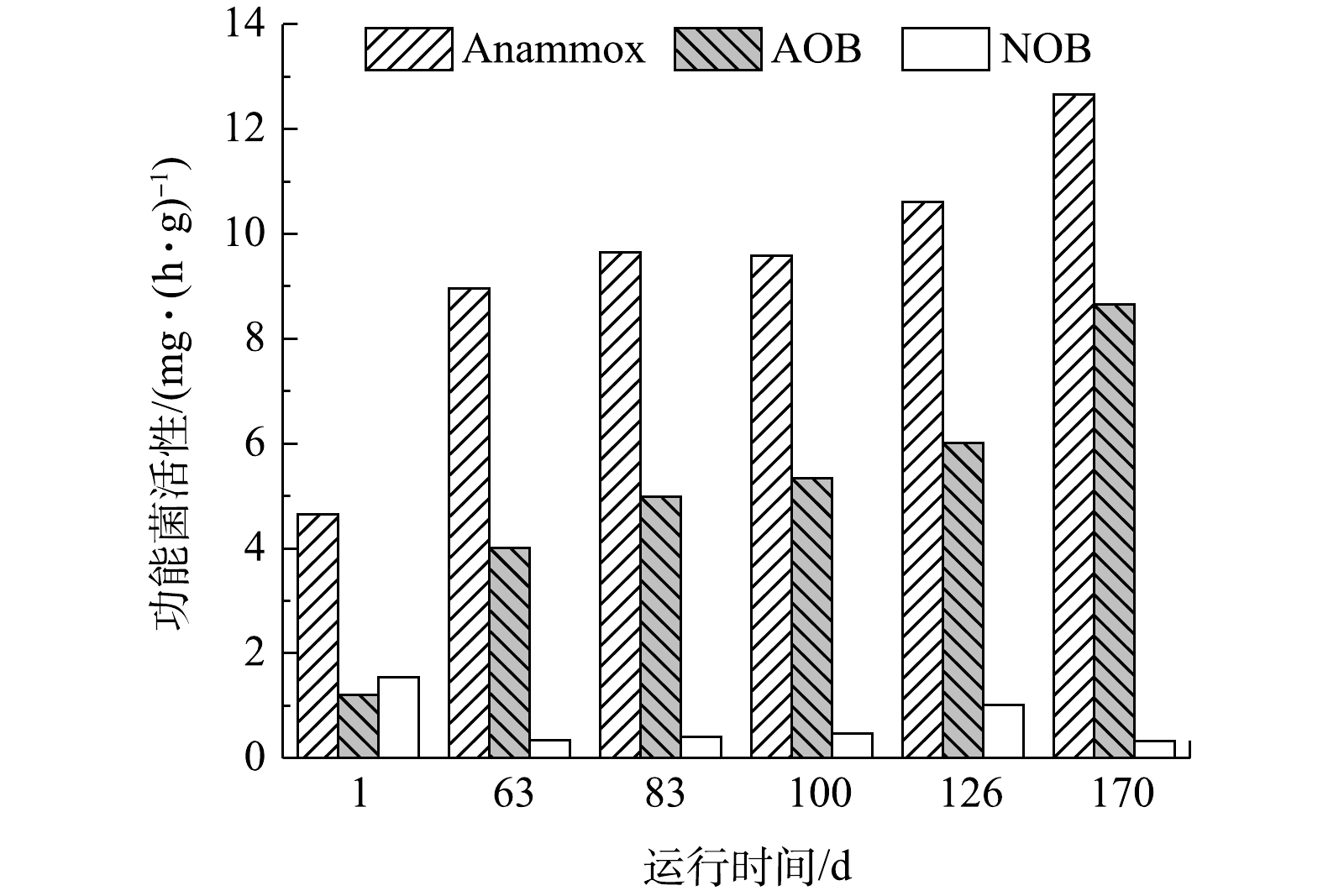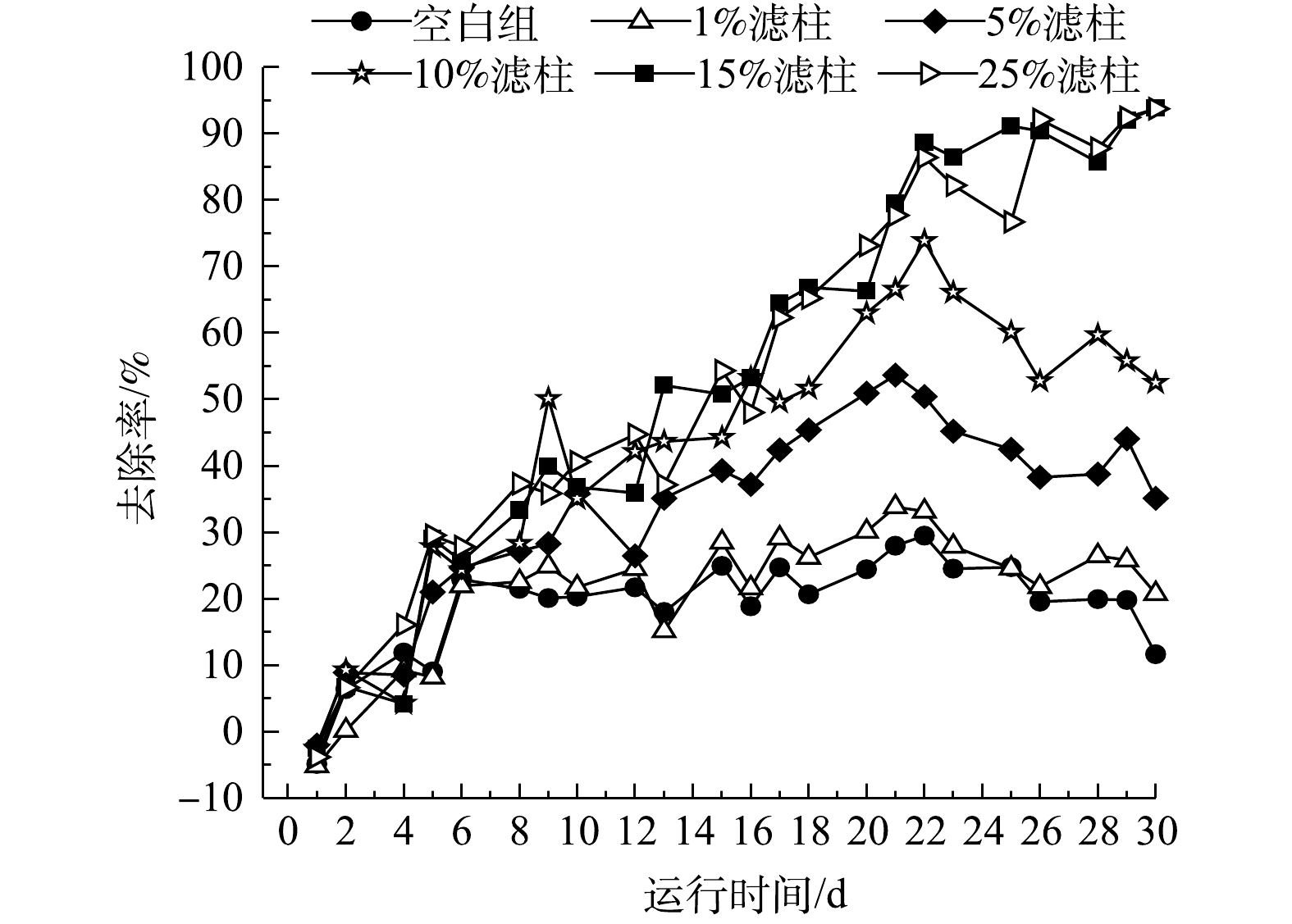-
厌氧氨氧化(anaerobic ammonium oxidation,Anammox)自1995年被发现便一直为污水处理领域的研究热点[1],具有不需要外加碳源、节省曝气能耗、污泥产量少、运行成本低等优势[2-3]。一段式短程硝化-厌氧氨氧化工艺,即首先好氧氨氧化菌(aerobic ammonia-oxidizing bacteria,AOB)在特定溶解氧等条件下将部分
NH+4 -N转化成NO−2 -N,再通过Anammox菌代谢作用,将NH+4 -N和NO−2 -N转化为NO−3 -N及N2。该工艺主要应用于处理垃圾渗滤液[4],畜禽养殖废水[5],化工废水[6]等高NH+4 -N废水。然而由式(1)可知,该工艺理论TN去除率为88%,仍然有10%以上的TN以NO−3 -N形式存在[7-8]。导致处理高NH+4 -N废水时,出水TN难以满足排放标准[9]。而且当没有完全抑制亚硝酸盐氧化菌(nitrite-oxidizing bacteria,NOB)活性时,一部分进水NH+4 -N被转化成NO−3 -N,导致出水NO−3 -N高于理论值[5]。因此,为使出水满足排放标准,应对出水NO−3 -N进行深度处理。目前用于深度去除
NO−3 -N的传统反硝化工艺,需要投加葡萄糖、甲醇、乙酸钠等有机碳源,存在投加量难以控制、影响出水水质、运行维护困难,以及易造成二次污染等诸多问题[10-11]。经济高效的硫自养反硝化工艺也被报道用于该类废水的深度脱氮,但需要消耗碱度,并且产生的大量硫酸盐会增加水体发黑变臭的潜在风险[12]。氢自养反硝化工艺,因氢气的制备及存储等问题,导致运行成本增加,且存在安全问题[13]。近年来,将固相缓释碳源作为反硝化碳源,逐渐成为研究及应用的热点。玉米芯,麦秆等天然固相碳源释碳不稳定,且含有非碳成分[14-15]。而高分子聚合物缓释碳源具有碳源释放缓慢,可长效释碳,且不会造成二次污染的优点[16-18]。高分子聚合物中聚羟基脂肪酸酯(polyhydroxyalkanoates,PHAs)是最合适用于反硝化脱氮的固体基质[19],其反硝化速率远高于麦秆等天然有机物质,且PHAs的成本较低[20]。近年来,PHAs中的聚羟基丁酸/戊酸酯(PHBV)作为反硝化碳源和生物膜载体的研究逐渐增多,显示了PHBV应用于生物反硝化脱氮领域的巨大潜力[21-22]。然而,目前将一段式短程硝化-厌氧氨氧化工艺与含有缓释碳源的滤柱耦合起来进行深度脱氮的研究鲜有报道。
综上所述,本文首先使用序批式反应器(sequencing batch reactor,SBR)研究一段式短程硝化-厌氧氨氧化工艺的启动驯化,当系统达到稳定运行后,其出水利用含有新型缓释碳源PHBV的滤柱进行深度脱氮,考察了不同缓释碳源体积填充比的滤柱中的运行效果,探索了缓释碳源的最佳体积填充比,为工程应用提供技术支持。
全文HTML
-
如图1所示。一段式短程硝化-厌氧氨氧化SBR为不锈钢材质,内径为23 cm,外径为34 cm,高度为50 cm,有效容积为18 L,排水比50%。反应器外层为水浴加热层,温度维持在30 ℃左右,反应器设有搅拌装置。由曝气泵和钛合金曝气头(曝气头孔径为10 μm,直径80 mm,高50 mm)来实现连续曝气,曝气量由气体流量计控制。反应器由PCL控制系统实现自动控制。运行总周期为12 h,进水12 min,曝气搅拌635 min,静置60 min,排水13 min。
滤柱均由有机玻璃制成,有效容积500 mL,按不同体积填充比将缓释碳源与火山石进行混合填充(1%、5%、10%、15%、25%),并设置空白组(只填充火山石,无缓释碳源)。实验采用PHBV为缓释碳源,PHBV具有生物可降解性和在水中的不可溶性这2个特点,为淡褐色颗粒状,购于宁波天安生物科技有限公司。
-
SBR接种污泥取自某污水处理厂厌氧氨氧化反应器。接种污泥混合液悬浮固体质量浓度(MLSS)为6 858 mg·L−1,混合液挥发性悬浮固体质量浓度(MLVSS)为3 580 mg·L−1。各滤柱中活性污泥采用自然挂膜培养。
SBR进水分别以(NH4)2SO4、NaNO2及NaHCO3作为
NH+4 -N、NO−2 -N和碱度的来源。各阶段投加营养盐10 mg·L−1 KH2PO4、5.6 mg·L−1 CaCl2·2H2O、300 mg·L−1 MgSO4·7H2O、1 250 mg·L−1 NaHCO3,以及微量元素Ⅰ1.25 mg·L−1和微量元素Ⅱ1.25 mg·L−1[23]。各滤柱的进水为SBR稳定运行阶段的出水。 -
在SBR中进行一段式短程硝化-厌氧氨氧化工艺的启动驯化及稳定运行,各阶段运行参数如表1所示。首先进水
NH+4 -N、NO−2 -N按照1∶1配制,Anammox菌活性恢复后通过逐步提高进水NH+4 -N和NO−2 -N配比、精确控氧曝气和投加羟胺的调控方式,完成一段式短程硝化-厌氧氨氧化工艺的启动。进水氮素质量浓度以曝气搅拌阶段初期为准;当SBR达到稳定运行后,将出水存至中间水箱,再通过蠕动泵进入不同缓释碳源体积填充比的滤柱。在15 ℃,pH为7.8~8.0,水力停留时间(hydraulic retention time, HRT)为 2.5 h,进水溶解氧(dissolved oxygen, DO)为(4.20±0.3) mg·L−1的条件下,考察不同缓释碳源体积填充比的滤柱的脱氮效果,以探究提高一段式短程硝化-厌氧氨氧化工艺TN去除率的有效方法。 -
各项指标测定方法均按照国标法[24]测定。
NH+4 -N:纳氏试剂分光光度法;NO−2 -N:N-(1-萘基)-乙二胺分光光度法;NO−3 -N:紫外分光光度法;MLVSS /MLSS:称重法;COD采用美国哈希快速消解仪;pH、DO、温度采用德国WTW 3430测定仪测定。在SBR各阶段末,参考张凯等[25]的方法测定污泥活性。根据厌氧氨氧化反应和一段式短程硝化-厌氧氨氧化反应的化学计量比方程可知,在NOB活性被抑制条件下,SBR中,厌氧氨氧化反应
NH+4 -N去除质量浓度NA、一段式短程硝化-厌氧氨氧化反应NH+4 -N去除质量浓度NPN-A和理论NO−3 -N积累质量浓度TNO−3 分别按式(2)、式(3)和式(4)计算。式中:NA为厌氧氨氧化反应
NH+4 -N去除质量浓度,mg·L−1;NPN-A为一段式短程硝化-厌氧氨氧化反应NH+4 -N去除质量浓度,mg·L−1;TNO−3 为理论NO−3 -N积累质量浓度,mg·L−1;CNO−2,in 进水NO−2 -N质量浓度,mg·L−1;CNO−2,out 出水NO−2 -N质量浓度,mg·L−1;CNH+4,in 进水NH+4 -N质量浓度,mg·L−1;CNH+4,out 出水NH+4 -N质量浓度,mg·L−1;
1.1. 实验装置
1.2. 接种污泥和实验用水
1.3. 实验方法
1.4. 分析方法与计算
-
1)脱氮性能分析。在SBR中通过逐步提高进水
NH+4 -N和NO−2 -N配比、精确控氧曝气和投加羟胺的调控方式,完成从厌氧氨氧化反应向一段式短程硝化-厌氧氨氧化反应的转变。因为SBR排水比为50%,剩余的50%中含有上周期未去除完全的NH+4 -N以及生成的NO−3 -N,故各阶段进水完毕后反应器内实际NH+4 -N值大于配水值。各阶段脱氮效果见图2~图6。第Ⅰ阶段(1~7 d)是Anammox菌适应阶段。进水
NH+4 -N和NO−2 -N配比为1∶1,其质量浓度均为50 mg·L−1,曝气量为50 mL·min−1,反应器中仅发生厌氧氨氧化反应。在第7天时NH+4 -N去除率达95%,NO−2 -N去除率达到62%,且实际NO−3 -N积累质量浓度低于理论NO−3 -N积累质量浓度。这说明反应器内Anammox菌活性良好,且抑制了NOB的活性[26]。第Ⅱ阶段(8~65 d)致力于提高AOB活性。为避免因
NO−2 -N积累而导致Anammox菌活性的抑制[27],从第8天开始调整进水NH+4 -N和NO−2 -N配比为2:1(进水NH+4 -N为50 mg·L−1,进水NO−2 -N为25 mg·L−1)。此后的35 d内,NH+4 -N去除率仅为(50±2)%,表明此时AOB活性较低。反应器内AOB活性不足是影响整个去除效果的关键原因[28],投加羟胺可抑制NOB活性,并且通过提高羟胺氧化酶(HAO)活性来刺激AOB的活性[29-30]。43~53 d每天投加10 mg·L−1羟胺,此后NH+4 -N去除率提高到98%。投加羟胺后一段式短程硝化-厌氧氨氧化反应NH+4 -N去除质量浓度由(11±2) mg·L−1升高到(28±2) mg·L−1,一段式NH+4 -N去除贡献率稳定在64%左右,说明AOB活性得到显著提高。第Ⅲ阶段(66~86 d)进水
NH+4 -N质量浓度提高至75 mg·L−1,NH+4 -N容积负荷达0.15 kg·(m3·d)−1,且按理论需氧量将曝气量提高至75 mL·min−1。由于曝气量的提高可刺激NOB活性,实际NO−3 -N积累质量浓度高于理论NO−3 -N积累质量浓度(5 mg·L−1以上)。73~80 d每天投加10 mg·L−1的羟胺以抑制NOB活性,至第85天实际NO−3 -N积累质量浓度接近理论NO−3 -N积累质量浓度,且一段式NH+4 -N去除贡献率稳定在70%左右。第Ⅳ阶段(86~102 d)提高进水
NH+4 -N至100 mg·L−1,相应提升曝气量至100 mL·min−1,同时86~91 d每天投加10 mg·L−1羟胺。至第102天,反应器内AOB活性不断增强,TN和NH+4 -N去除率分别稳定在(60±2)%和(68±3)%。至此,一段式NH+4 -N去除贡献率约为51%。第Ⅴ阶段(103~128 d)调整进水
NH+4 -N和NO−2 -N配比为10∶1,进水NO−2 -N为10 mg·L−1。此阶段NH+4 -N去除率由59%逐渐提升至68%,TN去除率由46%逐渐提升至55%。一段式短程硝化-厌氧氨氧化反应NH+4 -N去除质量浓度由58 mg·L−1逐渐增长到72 mg·L−1,一段式NH+4 -N去除贡献率达90%以上。123~128 d每天投加10 mg·L −1羟胺,使实际NO−3 -N积累质量浓度与理论NO−3 -N积累质量浓度相当。上述结果表明在长期运行中,阶段性投加羟胺有助于反应器的稳定运行,这与李佳等[31]的研究结果一致。第Ⅵ阶段(129~176 d)为一段式短程硝化-厌氧氨氧化工艺稳定运行阶段。
NH+4 -N负荷不变,进水NH+4 -N为100 mg·L−1,无NO−2 -N添加。反应器中完成由厌氧氨氧化反应到一段式短程硝化-厌氧氨氧化反应的转变,至第175天,一段式NH+4 -N去除贡献率约为100%,NH+4 -N去除率达98%。2)化学计量比分析。在实验过程中进行化学计量比分析,由此可以判断反应器中的脱氮途径[32]。由厌氧氨氧化反应方程式可知,厌氧氨氧化反应
ΔNO−3-N/ΔNH+4 -N和ΔTN/ΔNH+4 -N的理论值分别为0.26和2.0。而由式(1)可知一段式短程硝化-厌氧氨氧化反应ΔNO−3-N/ΔNH+4 -N和ΔTN/ΔNH+4 -N的理论值分别为0.11和0.88。如图7所示,第Ⅰ阶段ΔTN/
ΔNH+4 -N在2左右,各阶段逐渐下降,最终在第Ⅵ阶段稳定在一段式短程硝化-厌氧氨氧化反应的理论值0.88左右,说明随着进水参数的调整,AOB活性逐渐增强且一段式NH+4 -N去除贡献率逐渐升高。在第Ⅰ~Ⅴ阶段,
ΔNO−3-N/ΔNH+4 -N波动较大,为0~0.3。高于0.26的原因可能为反应器中存在NOB将部分NO−2 -N转化为了NO−3 -N,在投加羟胺后,ΔNO−3-N/ΔNH+4 -N便下降至理论值0.26~0.11。有研究也发现,ΔNO−3-N/ΔNH+4 -N低于理论值的现象[33],本研究中因为所接种污泥长期在厌氧状态下保存,故推测在接种初期反应器内存在反硝化反应。第Ⅵ阶段ΔNO−3-N/ΔNH+4 -N稳定在0.11左右,表明此时反应器中NOB活性被抑制,反硝化作用停止,且一段式短程硝化-厌氧氨氧化反应占绝对优势。第Ⅰ~Ⅴ阶段,各阶段初期
ΔNO−2-N/ΔNH+4 -N高于进水NO−2 -N/NH+4 -N,说明各阶段初期AOB活性不足,进水NH+4 -N未被完全消耗,但在各阶段末ΔNO−2 -N/ΔNH+4 -N十分接近进水NO−2 -N/NH+4 -N,说明各阶段中一段式短程硝化-厌氧氨氧化反应效果逐步提升。化学计量比的阶段性变化也说明,经过176 d的培养,反应器中完成由厌氧氨氧化反应到一段式短程硝化-厌氧氨氧化反应的转变。3)功能菌活性分析。为探究启动过程中各功能菌活性变化,在各阶段末取混合污泥,进行批式实验来测定其活性。如图8所示,接种初期Anammox菌活性为4.6 mg·(h·g)−1,第126天提升至10.6 mg·(h·g)−1。第Ⅵ阶段,经过44 d培养,Anammox菌活性提升至12.6 mg·(h·g)−1。张凯等[25]通过不断缩短HRT强化Anammox菌活性,经过188 d培养,Anammox菌活性增加至7.7 mg·(h·g)−1。MIAO等[34]在成功启动的一段式短程硝化-厌氧氨氧化工艺SBR中,经过178 d的稳定运行,Anammox菌活性由0.6 mg·(h·g)−1提升到1.2 mg·(h·g)−1。
经过170 d培养后,AOB活性由1.2 mg·(h·g)−1提升至8.6 mg·(h·g)−1,并且一段式短程硝化-厌氧氨氧化反应
NH+4 -N去除质量浓度逐渐提高,证明AOB活性是影响一段式短程硝化-厌氧氨氧化反应活性的关键因素[28]。李军等[35]使用一段式短程硝化-厌氧氨氧化工艺处理中低浓度废水,达到稳定运行时,AOB和Anammox菌活性分别为16.7 mg·(h·g)−1和9.2 mg·(h·g)−1,也证明了AOB活性的重要影响。本研究中AOB和Anammox菌活性逐渐上升,而NOB活性始终维持在1.0 mg·(h·g)−1以下,AOB和Anammox菌活性远大于NOB,这更有利于一段式短程硝化-厌氧氨氧化工艺的稳定运行。
-
1)不同缓释碳源体积填充比滤柱的脱氮效果分析。在15 ℃低温条件下,对SBR稳定运行阶段(147~176 d)出水进行深度脱氮研究。各滤柱缓释碳源体积填充比为1%、5%、10%、15%、25%,并设无缓释碳源添加的空白组。由于各滤柱进水中有SBR出水悬浮污泥且进水桶中DO约为4.2 mg·L−1,为滤柱中的短程硝化反应创造了条件[36],所以第1~30天内所有滤柱中均发生短程硝化-厌氧氨氧化反应,研究结果如图9所示。
在第1~8天,空白组和1%滤柱
NH+4 -N去除量均小于为10 mg·L−1,NO−2 -N积累量为(3.5±0.5) mg·L−1,说明启动初期AOB具有一定的活性,且Anammox菌正在逐步的适应15 ℃的新条件。在15~19天,空白组和1%滤柱中的NO−2 -N积累量为(0.5±0.25) mg·L−1,NO−3 -N积累量为(1.0±04) mg·L−1,且NH+4 -N去除量均达到(15.2±2.5) mg·L−1,说明空白组和1%滤柱中,只发生一段式短程硝化-厌氧氨氧化反应。5%~25%滤柱中Anammox菌也逐渐适应新环境。第15~19天,
NH+4 -N去除量分别达到(18.4±0.6)、(16.5±0.8)、(15.9±0.6)、(15.8±0.8) mg·L−1,其中10%滤柱、15%滤柱和25%滤柱中NH+3 -N去除量始终与空白组基本一致,但5%滤柱中NH+3 -N去除量较高,推测5%滤柱中碳源不足,故具有短程反硝化效果,进一步促进了NH+4 -N的去除[37]。从第5天开始,随着反硝化菌(denitrifying bacteria,DNB)的富集,至第30天NO−3 -N去除量分别增至7.0、13.3、28.3、28.2 mg·L−1,说明较低的缓释碳源体积填充比不利于DNB对NO−3 -N的去除[38]。5%~25%滤柱中成功实现了反硝化反应与一段式短程硝化-厌氧氨氧化反应的共存。李昂等[39]在PHBV和沸石的分区式耦合反应器中实现厌氧氨氧化反应与反硝化反应耦合系统的启动。LI等[40]研究表明,在反应器中添加固态碳源聚己内酯对反应器出水未造成不良影响。由于滤柱中微生物是自然挂膜生成,所以各滤柱中缓释碳源溶解性有机物的产生与消耗保持稳定状态,未出现启动初期出水COD过高的情况[39,41],1%~25%滤柱平均出水COD值分别为11.2、14.3、17.3、19.3、32.9 mg·L−1。由图10可知,15%滤柱和25%滤柱的TN去除率均达到93.8%,说明15%滤柱和25%滤柱均可提供充足碳源。综合考虑脱氮效果、出水COD和缓释碳源填充量,得出在该运行条件下,最佳缓释碳源体积填充比为15%。
2)耦合系统TN去除效果分析。对SBR与15%滤柱组成的耦合系统进行TN去除效果分析。由图11可知,因为第5天15%滤柱中出现反硝化作用,且Anammox菌适应了滤柱中的环境而提升了一段式短程硝化-厌氧氨氧化的反应效果,故第5天开始耦合系统TN去除率开始升高。耦合体系在第22 天达到最佳脱氮效果,第22~30天,SBR进水TN为(125±4) mg·L−1,SBR出水TN为(40±5) mg·L−1,但15%滤柱中出水TN小于5 mg·L−1。第22~30天,SBR中平均TN去除率为67.8%,而耦合系统平均TN去除率达96.7%以上,TN去除率增高了28.9%,比一段式短程硝化-厌氧氨氧化反应理论TN去除率高8.7%。在目前报道的提升一段式短程硝化-厌氧氨氧化反应TN去除率的研究中属于较高水平[42-43]。
2.1. 一段式短程硝化-厌氧氨氧化工艺的启动及稳定运行
2.2. 深度脱氮分析
-
1)通过逐步提高进水
NH+4 -N和NO−2 -N配比、精确控氧曝气和投加羟胺的调控方式,成功启动一段式短程硝化-厌氧氨氧化反应器,最终NH+4 -N去除率达98%,TN去除率达73%,ΔNO−3−N/ΔNH+4 -N和ΔTN/ΔNH+4 -N 稳定在理论值0.11和0.88左右。2)阶段性投加羟胺,对刺激AOB的活性和抑制NOB的活性有显著效果,最终AOB和Anammox菌活性分别提高至8.6 mg·(h·g)−1和12.6 mg·(h·g)−1,而NOB活性低于0.5 mg·(h·g)−1。
3)在15 ℃低温条件下,缓释碳源体积填充比为15%的滤柱具有最佳的脱氮效果,出水TN小于5 mg·L−1,平均出水COD值为19.3 mg·L−1,且碳源的释放与消耗保持稳定状态。缓释碳源体积填充比为15%的滤柱中在一段式短程硝化-厌氧氨氧化反应与反硝化反应的共同作用下完成深度脱氮。
4) SBR与缓释碳源体积填充比为15%的滤柱组成的耦合系统中平均TN去除率达到96.7%,与SBR相比,TN去除率提升了28.9%,且比一段式短程硝化-厌氧氨氧化反应理论TN去除率高8.7%。通过SBR与缓释碳源体积填充比为15%的滤柱的耦合,TN去除率得到有效提升。










 下载:
下载:

